Deconstructing Immersion in the Experience Economy Framework for Immersive Dining Experiences through Mixed Reality
Abstract
1. Introduction
2. Literature Review
2.1. Experience Economy Framework
2.2. Immersive Experiences in Food and Dining
3. Research Design
3.1. Stimulus Material
3.2. Participants
3.3. Research Design
3.3.1. Retrospective Think Aloud Protocol
3.3.2. Galvanic Skin Response (GSR)
3.3.3. Benefit of RTAP and GSR Data Triangulation
3.4. Data Analysis
4. Findings
4.1. Immersive Experience Facilitators across the Mixed Reality Experience
4.2. Redefining Empathic/Social Immersion
“When we entered the supermarket, I thought about this farm shop across from my parent’s house, which is at a farm, and they sell asparagus and strawberries and stuff like that.” (P20)
“And it’s like a situation everybody’s been in, at least like, I grew up in the country. Like, you’ve been on a farm, you’ve been to a store like this. The guy behind the counter, I know a guy like that quite well, so it was really easy to visualize yourself in this situation”(P8)
“And just the hearts coming off the cows head, I think that’s really good. So I know that the cows enjoying it in this simulation, whereas ‘m not just throwing something at him and he’s not reacting.” (P2)
“I really like the name Waffles. I kind of focused on the fact that he said he will look forward to it. Because he used ‘he’ and therefore humanized the calf. Instead of ‘it’.” (P5)
4.3. Consumer Choices
4.4. Embedding Curiosity in Content Design
“So you’re sort of wondering, but what would it be? I see veggies, I see bottles and different things. So what has he made instead?” (P15)
“It was actually the first time I use glasses like this. It was a new experience, but I actually liked it.” (P7)
4.5. The Role of Technology in Immersive Experiences
“That it was too much is just your first impression because you just you don’t know how the glasses work. I have never seen it before. So then the first Act is really too much. So when the first person, the owner of the shop, talked to you I was just more focused on. ‘Oh, my God, there is a shop. I see it in front of me. But now you’re getting used to. Okay, so I was talking to you. You have a scene and you can choose the options. Yeah. You’re just getting more used to it. So then it’s not too much.”(P16)
4.6. Narrative Design
5. Discussion
6. Conclusions
Author Contributions
Funding
Institutional Review Board Statement
Informed Consent Statement
Data Availability Statement
Conflicts of Interest
References
- Perez, P.; Gonzalez-Sosa, E.; Kachach, R.; Ruiz, J.; Benito, I.; Pereira, F.; Villegas, A. Immersive gastronomic experience with distributed reality. In Proceedings of the 2019 IEEE 5th Workshop on Everyday Virtual Reality (WEVR), Osaka, Japan, 23–24 March 2019; IEEE: New York, NY, USA, 2019; pp. 1–6. [Google Scholar]
- Sester, C.; Deroy, O.; Sutan, A.; Galia, F.; Desmarchelier, J.F.; Valentin, D.; Dacremont, C. “Having a drink in a bar”: An immersive approach to explore the effects of context on drink choice. Food Qual. Prefer. 2013, 28, 23–31. [Google Scholar] [CrossRef]
- Fan, S.; Teng, P.; Chew, P.; Smith, G.; Copeland, L. Food system resilience and COVID-19–Lessons from the Asian experience. Glob. Food Secur. 2021, 28, 100501. [Google Scholar] [CrossRef]
- Jung, T.; Dieck, M.; Lee, H.; Chung, N. Effects of virtual reality and augmented reality on visitor experiences in museum. In Information and Communication Technologies in Tourism 2016; Springer: Cham, Switzerland, 2016; pp. 621–635. [Google Scholar]
- Kerrebroeck, H.V.; Brengman, M.; Willems, K. Escaping the crowd: An experimental study on the impact of a Virtual Reality experience in a shopping mall. Comput. Hum. Behav. 2017, 77, 437–450. [Google Scholar] [CrossRef]
- Griskevicius, V.; Cantú, S.M.; Van Vugt, M. The evolutionary bases for sustainable behavior: Implications for marketing, policy, and social entrepreneurship. J. Public Policy Mark. 2012, 31, 115–128. [Google Scholar] [CrossRef]
- Sung, E.C.; Han DI, D.; Bae, S.; Kwon, O. What drives technology-enhanced storytelling immersion? The role of digital humans. Comput. Hum. Behav. 2022, 132, 107246. [Google Scholar] [CrossRef]
- Dionísio, M.; Teixeira, D.; Shen, P.; Dinis, M.; Chen, M.; Nunes, N.; Nisi, V.; Paiva, J. Eat & Travel: A New Immersive Dining Experience for Restaurants. In International Conference on Advances in Computer Entertainment Technology; Springer: Cham, Switzerland, 2013; pp. 532–535. [Google Scholar]
- Crofton, E.C.; Botinestean, C.; Fenelon, M.; Gallagher, E. Potential applications for virtual and augmented reality technologies in sensory science. Innov. Food Sci. Emerg. Technol. 2019, 56, 102178. [Google Scholar] [CrossRef]
- Huang, J. The dining experience of Beijing Roast Duck: A comparative study of the Chinese and English online consumer reviews. Int. J. Hosp. Manag. 2017, 66, 117–129. [Google Scholar] [CrossRef]
- Zhu, D.; Wang, J.; Wang, P.; Xu, H. How to Frame Destination Foodscapes? A Perspective of Mixed Food Experience. Foods 2022, 11, 1706. [Google Scholar] [CrossRef]
- Dierking, L.D.; Falk, J.H. Redefining the museum experience: The interactive experience model. Visit. Stud. 1992, 4, 173–176. [Google Scholar]
- Ranasinghe, N.; Lee, K.Y.; Suthokumar, G.; Do EY, L. Virtual ingredients for food and beverages to create immersive taste experiences. Multimed. Tools Appl. 2016, 75, 12291–12309. [Google Scholar] [CrossRef]
- Van Bergen, G.; Zandstra, E.H.; Kaneko, D.; Dijksterhuis, G.B.; de Wijk, R.A. Sushi at the beach: Effects of congruent and incongruent immersive contexts on food evaluations. Food Qual. Prefer. 2021, 91, 104193. [Google Scholar] [CrossRef]
- Schöniger, M.K. The role of immersive environments in the assessment of consumer perceptions and product acceptance: A systematic literature review. Food Qual. Prefer. 2021, 99, 104490. [Google Scholar] [CrossRef]
- Pine, B.J.; Gilmore, J.H. Welcome to the experience economy. Harv. Bus. Rev. 1998, 76, 97–105. [Google Scholar] [PubMed]
- Haggis-Burridge, M. Personal and social recent history in Fragments of Him: Defining and exploring ‘Immersion’ in video games. In Return to the Interactive Past: The Interplay of Video Games and Histories; Sidestone Press: Leiden, The Netherlands, 2021; pp. 75–87. [Google Scholar]
- Leslie, D.; Brydges, T.; Brail, S. Qualifying aesthetic values in the experience economy. In Spatial Dynamics of the Experience Economy; Lorentzen, A., Larsen, K., Schroder, L., Eds.; Routledge: London, UK, 2015; pp. 88–102. [Google Scholar]
- Petermans, A.; Cleempoel, K.V. Retail design, experience economy and the greying population: A European perspective. In Proceedings of the 8th European Academy of Design Conference, Aberdeen, Scotland, 1–3 April 2009; pp. 1–3. [Google Scholar]
- Degen, M.; Melhuish, C.; Rose, G. Producing place atmospheres digitally: Architecture, digital visualisation practices and the experience economy. J. Consum. Cult. 2017, 17, 3–24. [Google Scholar] [CrossRef]
- Klingmann, A. Brandscapes: Architecture in the Experience Economy; MIT Press: Cambridge, MA, USA, 2010. [Google Scholar]
- Lorentzen, A. Cities in the experience economy. In The City in the Experience Economy; Routledge: London, UK, 2013; pp. 19–36. [Google Scholar]
- Pushkareva, L. Experience Economy in the System of Culture and Education. 2019. Available online: https://ssrn.com/abstract=3500376 (accessed on 7 November 2022).
- Kim, J.H.; Ritchie, J.B.; McCormick, B. Development of a scale to measure memorable tourism experiences. J. Travel Res. 2012, 51, 12–25. [Google Scholar] [CrossRef]
- Oh, H.; Fiore, A.M.; Jeoung, M. Measuring experience economy concepts: Tourism applications. J. Travel 2007, 46, 119–132. [Google Scholar] [CrossRef]
- Gilmore, J.H.; Pine, B.J. Differentiating hospitality operations via experiences: Why selling services is not enough. Cornell Hotel. Restaur. Adm. Q. 2002, 43, 87–96. [Google Scholar] [CrossRef]
- Quadri-Felitti, D.L.; Fiore, A.M. Destination loyalty: Effects of wine tourists’ experiences, memories, and satisfaction on intentions. Tour. Hosp. Res. 2013, 13, 47–62. [Google Scholar] [CrossRef]
- Moorhouse, N.; Jung, T. Augmented reality to enhance the learning experience in cultural heritage tourism: An experiential learning cycle perspective. Ereview Tour. Res. 2017, 8. [Google Scholar]
- Dailymail Seafood Served with an Ipod: Heston Blumenthal’s Latest Recipe. 2007. Available online: https://www.dailymail.co.uk/news/article-448840/Seafood-served-ipod-Heston-Blumenthals-latest-recipe.html (accessed on 7 November 2022).
- Gilboy, M.B.; Bill, D.E. Cultural Immersion Experience: Promoting an Understanding of Mexican American Nutrition and Food Traditions. J. Nutr. Educ. Behav. 2011, 43, 419–420. [Google Scholar] [CrossRef] [PubMed]
- Harper, W.J.; Courtney, P.D.; Chism, G.W., III. An immersion approach to teaching food science. J. Food Sci. Educ. 2003, 2, 53–56. [Google Scholar] [CrossRef]
- Qvist, P.; Trygg, N.B.; Luimula, M.; Peltola, A.; Suominen, T.; Heikkinen, V.; Tuominen, P.; Tuusvuori, O. Medieval gastro box—Utilizing VR technologies in immersive tourism experiences. In Proceedings of the 2016 7th IEEE International Conference on Cognitive Infocommunications (CogInfoCom), Wroclaw, Poland, 16–18 October 2016; IEEE: New York, NY, USA, 2016; pp. 000077–000078. [Google Scholar]
- Celikcan, U.; Bülbül, A.Ş.; Aslan, C.; Buyuktuncer, Z.; Işgın, K.; Ede, G.; Kanbur, N. The virtual cafeteria: An immersive environment for interactive food portion-size education. In Proceedings of the 3rd International Workshop on Multisensory Approaches to Human-Food Interaction, Boulder, CO, USA, 16 October 2018; pp. 1–5. [Google Scholar]
- Ung, C.Y.; Menozzi, M.; Hartmann, C.; Siegrist, M. Innovations in consumer research: The virtual food buffet. Food Qual. Prefer. 2018, 63, 12–17. [Google Scholar] [CrossRef]
- Kuleto, V.; Stanescu, M.; Ranković, M.; Šević, N.P.; Păun, D.; Teodorescu, S. Extended reality in higher education, a responsible innovation approach for generation y and generation z. Sustainability 2021, 13, 11814. [Google Scholar] [CrossRef]
- Haak, M.V.D.; De Jong, M.; Jan Schellens, P. Retrospective vs. concurrent think-aloud protocols: Testing the usability of an online library catalogue. Behav. Inf. Technol. 2003, 22, 339–351. [Google Scholar] [CrossRef]
- Tan, C.T.; Leong, T.W.; Shen, S. Combining think-aloud and physiological data to understand video game experiences. In Proceedings of the SIGCHI Conference on Human Factors in Computing Systems, Toronto, ON, Canada, 26 April–1 May 2014; pp. 381–390. [Google Scholar]
- Strijbosch, W.; Mitas, O.; van Blaricum, T.; Vugts, O.; Govers, C.; Hover, M.; Gelissen, J.; Bastiaansen, M. Evaluating the temporal dynamics of a structured experience: Real-time skin conductance and experience reconstruction measures. Leis. Sci. 2021, 1–25. [Google Scholar] [CrossRef]
- Laeremans, M.; Dons, E.; Avila-Palencia, I.; Carrasco-Turigas, G.; Orjuela, J.P.; Anaya, E.; Panis, L.I. Physical activity and sedentary behaviour in daily life: A comparative analysis of the Global Physical Activity Questionnaire (GPAQ) and the Sense Wear armband. PLoS ONE 2017, 12, e0177765. [Google Scholar] [CrossRef] [PubMed]
- Green, A. Verbal Protocol Analysis in Language Testing Research: A Handbook; Cambridge University Press: Cambridge, UK, 1998; Volume 5. [Google Scholar]
- Stanton, N.A.; Salmon, P.M.; Rafferty, L.A.; Walker, G.H.; Baber, C.; Jenkins, D.P. Human Factors Methods: A Practical Guide for Engineering and Design; CRC Press: Boca Raton, FL, USA, 2017. [Google Scholar]
- Ericsson, K.A.; Simon, H.A. Protocol Analysis: Verbal Reports as Data; The MIT Press: Cambridge, MA, USA, 1984. [Google Scholar]
- Taylor, S.; Jaques, N.; Chen, W.; Fedor, S.; Sano, A.; Picard, R. Automatic identification of artifacts in electrodermal activity data. In Proceedings of the 2015 37th Annual International Conference of the IEEE Engineering in Medicine and Biology Society (EMBC), Milano, Italy, 25–29 August 2015; IEEE: New York, NY, USA, 2015; pp. 1934–1937. [Google Scholar]
- Boucsein, W. Principles of electrodermal phenomena. In Electrodermal Activity; Springer: Boston, MA, USA, 2012; pp. 1–86. [Google Scholar]
- Benedek, M.; Kaernbach, C. A continuous measure of phasic electrodermal activity. J. Neurosci. Methods 2010, 190, 80–91. [Google Scholar] [CrossRef] [PubMed]
- Korn, O.; Stamm, L.; Moeckl, G. Designing Authentic Emotions for Non-Human Characters: A Study Evaluating Virtual Affective Behavior. In Proceedings of the 2017 conference on designing interactive systems, Edinburgh, UK, 10–14 June 2017; pp. 477–487. [Google Scholar]
- Tversky, A.; Kahneman, D. The framing of decisions and the psychology of choice. Science 1981, 211, 453–458. [Google Scholar] [CrossRef] [PubMed]
- Tom Dieck, M.C.; Jung, T.; Han, D.I. Mapping requirements for the wearable smart glasses augmented reality museum application. J. Hosp. Tour. Technol. 2016, 7. [Google Scholar] [CrossRef]
- Balasubramanian, K.; Konar, R. Moving forward with augmented reality menu: Changes in food consumption behaviour patterns. Asia-Pac. J. Innov. Hosp. Tour. 2022, 11, 91–96. [Google Scholar]
- De Wijk, R.A.; Kaneko, D.; Dijksterhuis, G.B.; van Bergen, G.; Vingerhoeds, M.H.; Visalli, M.; Zandstra, E.H. A preliminary investigation on the effect of immersive consumption contexts on food-evoked emotions using facial expressions and subjective ratings. Food Qual. Prefer. 2022, 99, 104572. [Google Scholar] [CrossRef]
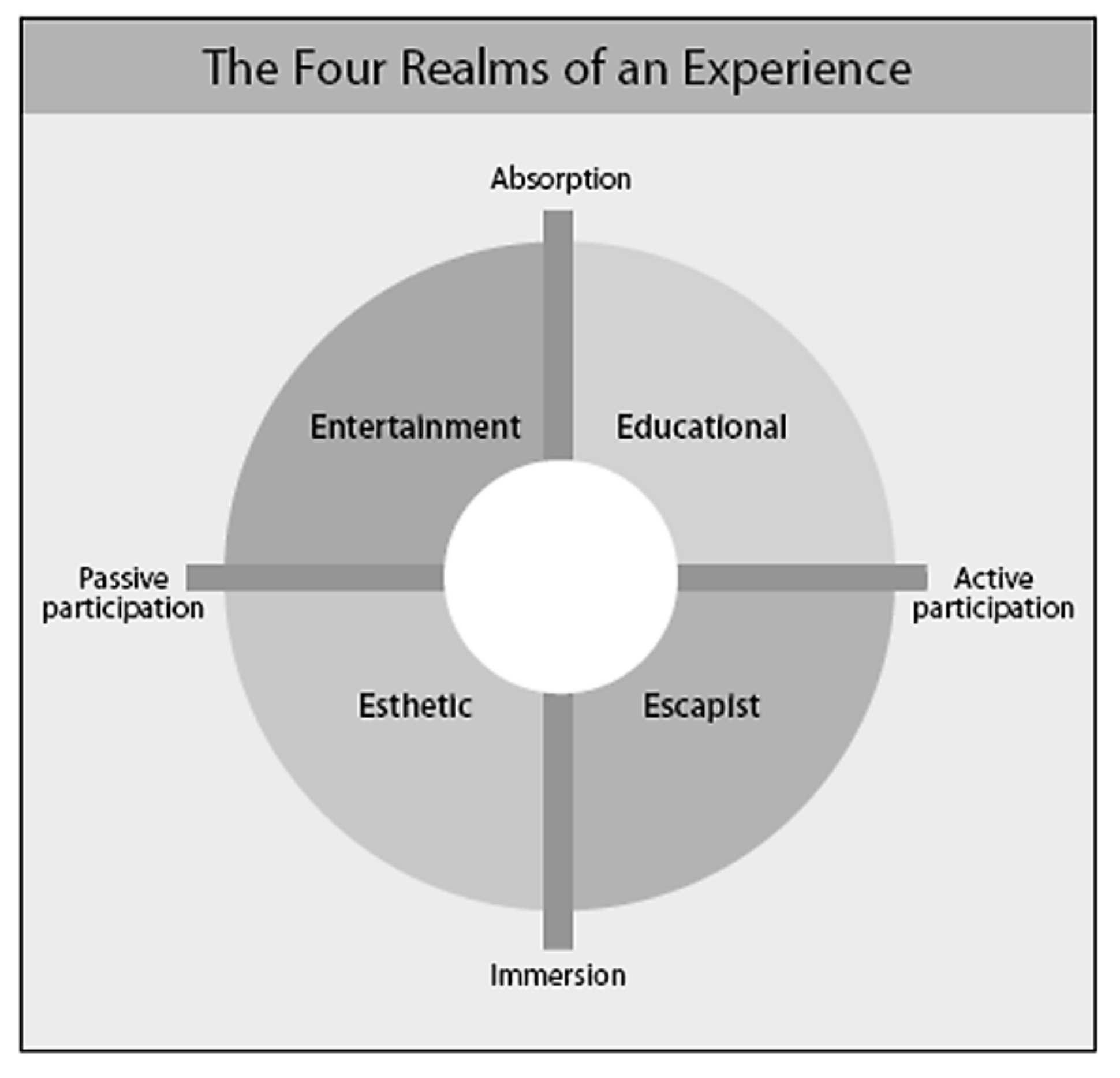
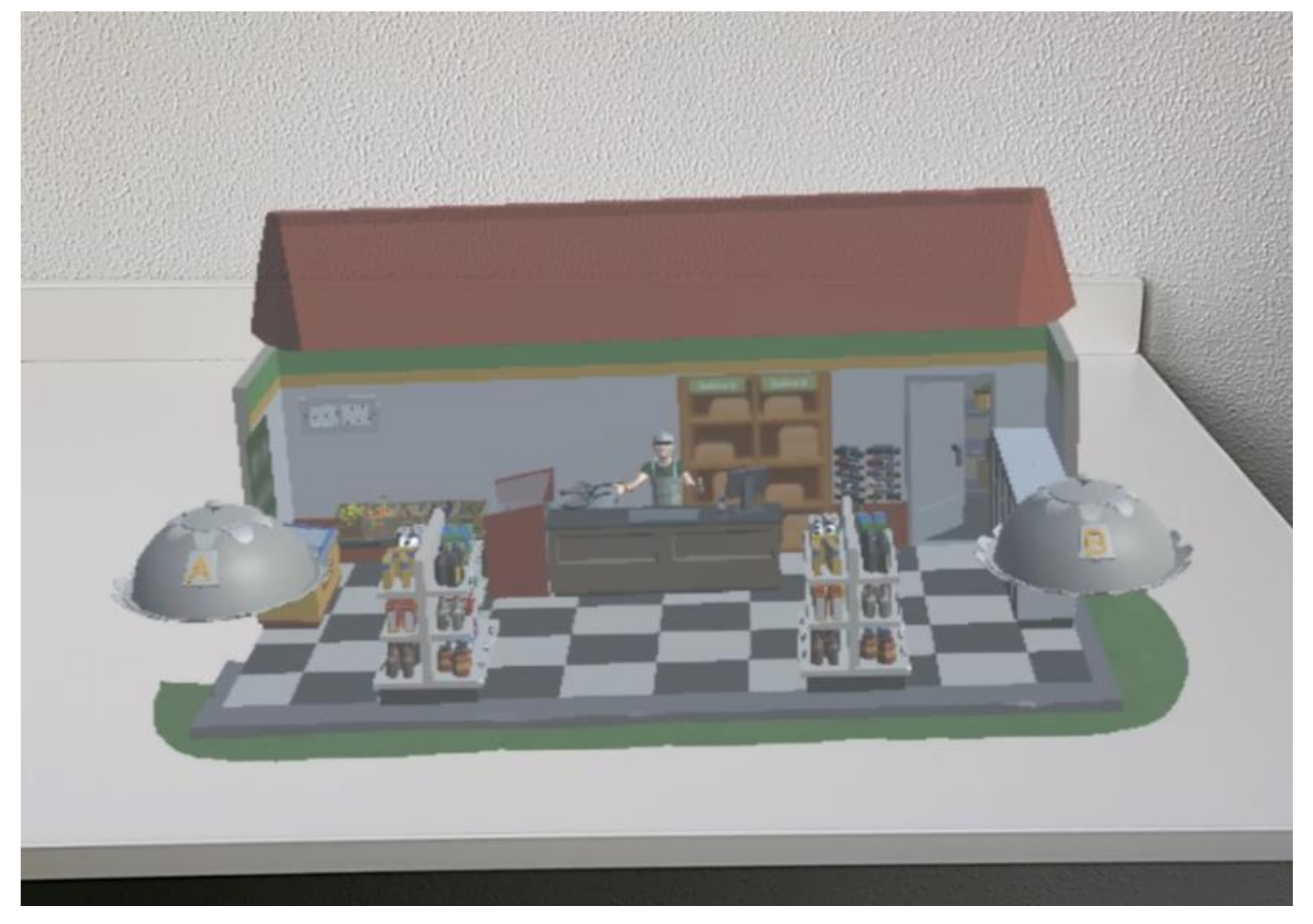
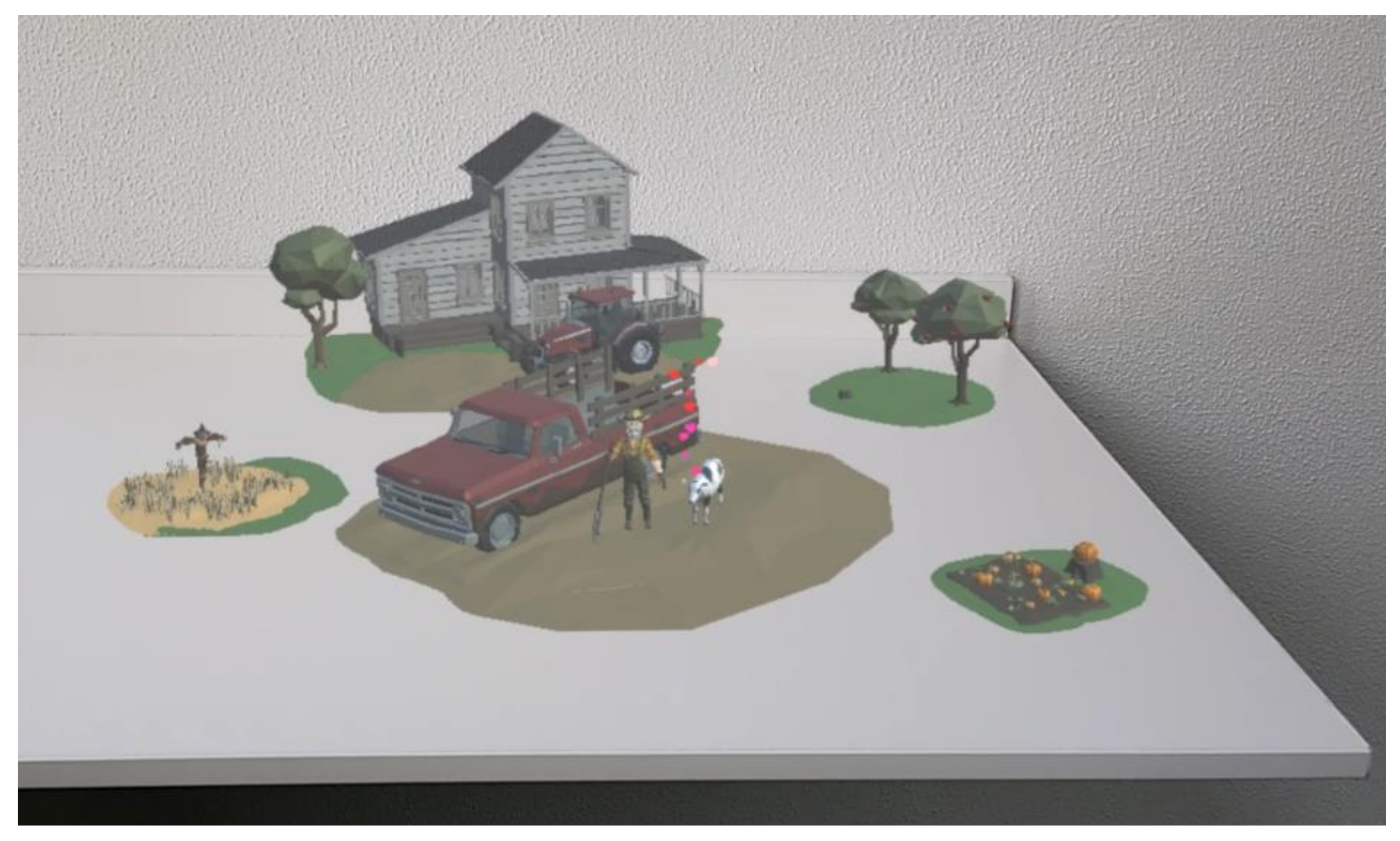
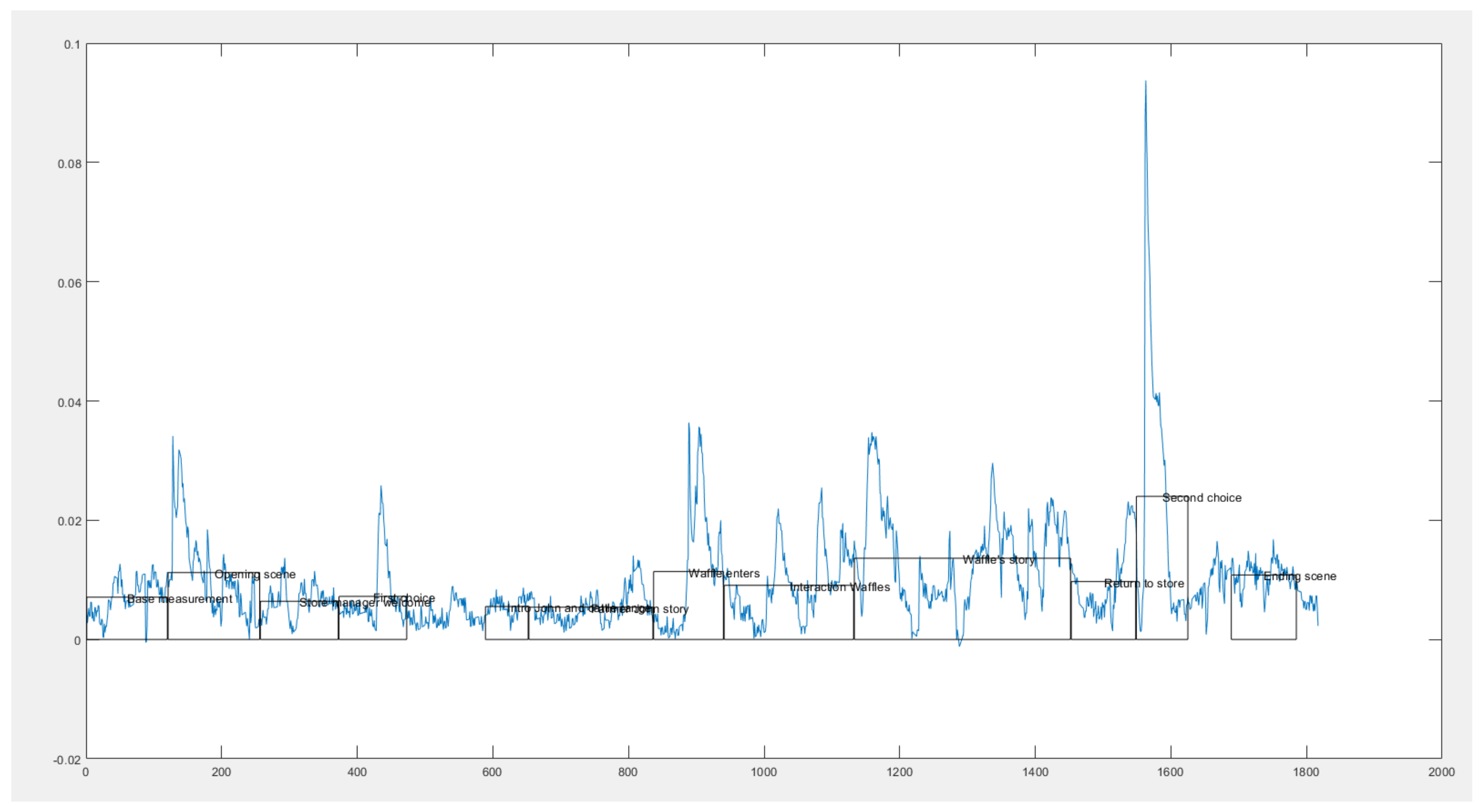
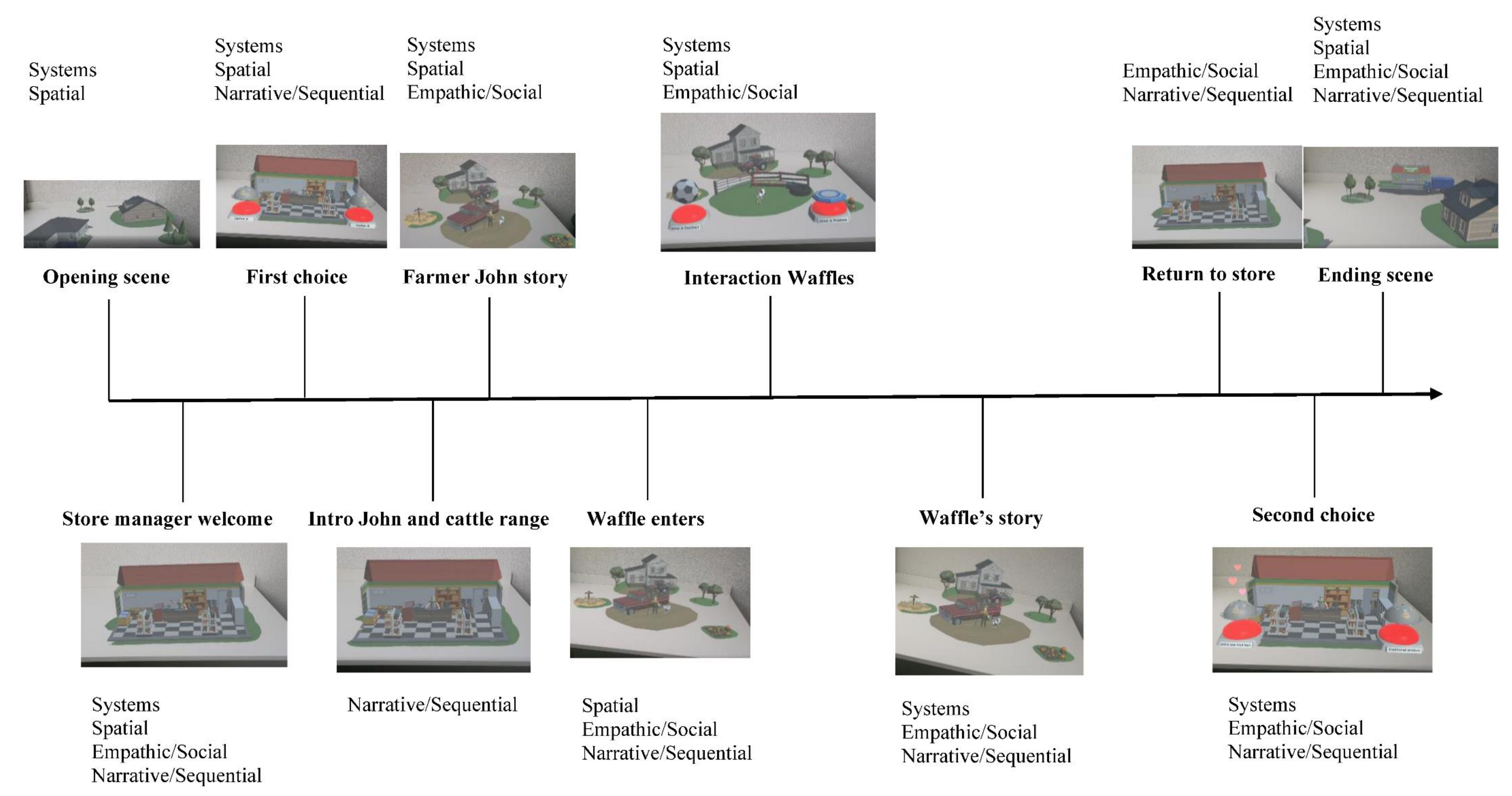
| Author | Study | Type of Immersion | Sample and Method | Key Findings | Related Realms of the Experience Economy |
|---|---|---|---|---|---|
| 10. Dionísio et al. (2013) | Testing Eat & Travel prototype solution in immersive CAVE setting | Spatial Social Narrative | Proof of concept | Immersive CAVE setup engages guests to interact and explore. Guests perceived to be immersed and sense of presence in the virtual environment. Guests have the desire to learn and share information about the food and destination. Meaningful connection can be established between guest and NPC (non-player character) | Escapist Entertainment |
| 35. Qvist et al. (2016) | Elevating the level of immersion in CAVE environments for location independent multisensory gastronomic services | Spatial | Proof of concept | Multisensory CAVE settings can be used to provide sensory and cognitive engagement in form of an immersive dining experience. | Escapist |
| 38. Sester et al. (2012) | Evaluate the effect of contextual stimuli through visual projections on drink choices | Spatial | Experimental study in two immersive bars (Study 1: N = 176; Study 2: N = 120) | Food behavior can be tested through immersive CAVE setups to test various contextual influences on food behavior | Escapist Esthetic |
| 46. Ung et al. (2018) | Use of VR to examine people’s real food choices | Spatial | Experimental study (N = 34) | VR is a suitable tool for researching people’s real food choice behavior | Escapist |
| 30. Perez et al. (2019) | Distributed Reality as innovative concept for creating immersive gastronomic experiences | Spatial | System evaluation study (N = 66) | Distributed Reality provides an innovative concept in hospitality and tourism to combine local and remote environments through VR | Escapist |
| 18. Harper et al. (2003) | Immersion approach to teach basic concepts of food science | Systems Social | Analysis of pre- and post-test results (N = 22) | Immersive, team-based teaching approach helps students recall basic concepts and acquire a broad knowledge base in food science | Educational |
| 13. Gilboy & Bill (2011) | Cultural immersion experience as educational method to increase cultural awareness and understanding | Systems Empathic Spatial | Content analysis on reflective participant journals (N = 16) | Cultural immersive experiences increase understanding of foreign cultures and can promote behavioral change post-experience | Escapist Educational |
| 4. Celikcan et al. (2018) | Immersive virtual environment for interactive food portion-size education | Spatial Systems | Usability test of the virtual environment | High detailed virtual environments through VR can be used for immersive educational purposes providing multisensory immediate feedback and high level of interaction | Escapist Educational |
| 36. Ranasinghe et al. (2016) | Use of electrical pulses and virtual overlays to create and modify Immersive taste experiences | Systems | Experimental study in laboratory setting | Technological modifications (virtual food and beverage ingredients) are able to change taste experiences in food and beverage consumption and generate immersive experiences | Esthetic |
| Participant Code | Gender (M/F) | Country of Origin |
|---|---|---|
| P1 | F | The Netherlands |
| P2 | F | Taiwan |
| P3 | F | The Netherlands |
| P4 | M | The Netherlands |
| P5 | M | Germany |
| P6 | M | The Netherlands |
| P7 | F | The Netherlands |
| P8 | M | The Netherlands |
| P9 | F | India |
| P10 | M | Germany |
| P11 | F | The Netherlands |
| P12 | F | The Netherlands |
| P13 | M | Syria |
| P14 | F | The Netherlands |
| P15 | F | The Netherlands |
| P16 | F | The Netherlands |
| P17 | F | The Netherlands |
| P18 | F | The Netherlands |
| P19 | F | The Netherlands |
| P20 | F | The Netherlands |
| Systems Immersion | Spatial Immersion | Empathic/Social Immersion | Narrative/Sequential Immersion | |
|---|---|---|---|---|
| Codes | MR user experience | Personal context environment | Empathy through character narrative | Curiosity |
| User Interaction (UI) | VE impression | Empathy through character narrative | Curiosity | |
| Distraction through device interaction | Sustainability in VE | Personal context environment | Choice based on novelty | |
| Empathy through character interaction | Intentional behavior through VE | Empathy through character narrative | Bewilderment of choice | |
| VE impression | VE impression | Reflection on sustainability issues | Distraction through content narrative | |
| MR user experience | choice based on personal context | Personal context environment | Personal context environment | |
| MR user experience | Reflection on sustainability issues | Distraction through content narrative | Distraction through content narrative | |
| MR user experience | Exclusive shopping experience | Intentional behavior through VE | Rational processing of narrative | |
| MR user experience | Personal context environment | Intentional behavior through VE | Sustainability in narrative | |
| VE impression | Distraction through content narrative | Rational processing of narrative | ||
| VE impression | Personal context narrative | Rational processing of narrative | ||
| MR User experience | Empathy through character interaction | Curiosity | ||
| choice based on personal context | Reflection through narrative | Reflection on sustainability issues | ||
| Experience evaluation | Intentional behavior through VE | Rational processing of narrative | ||
| VE impression | Empathy through character interaction | Curiosity | ||
| Distraction through content narrative | Distraction through content narrative | |||
| Personal context narrative | Choice based on novelty | |||
| Empathy through character narrative | choice based on personal context | |||
| Intentional behavior through VE | Bewilderment of choice | |||
| Personal context narrative | Interpretation of objects | |||
| Reflection on sustainability issues | Curiosity | |||
| Experience evaluation | Rational processing of narrative | |||
| Reflection through narrative | ||||
| Reflection on sustainability issues |
| Immersive Experience Facilitator | Example Quote |
|---|---|
| Systems Immersion | “It was also really cool to have my first experience with VR. I did not have that already. The view was really clear and the audio also.” P3 |
| Spatial Immersion | “It felt very realistic, surprisingly. There was a lot going on, I was looking around.” P4 |
| Empathic/Social Immersion | “When he told me that it would make him really happy. I thought, ‘Oh, I would love to do make him even more happy.” P14 |
| Narrative/Sequential Immersion | “So here I understood that by letting the cow live outside and more freely without being caged makes them not only happier but also just healthier. And that in turn also affects the food we eat that that the cow produces.” P2 |
Publisher’s Note: MDPI stays neutral with regard to jurisdictional claims in published maps and institutional affiliations. |
© 2022 by the authors. Licensee MDPI, Basel, Switzerland. This article is an open access article distributed under the terms and conditions of the Creative Commons Attribution (CC BY) license (https://creativecommons.org/licenses/by/4.0/).
Share and Cite
Han, D.-I.D.; Boerwinkel, M.; Haggis-Burridge, M.; Melissen, F. Deconstructing Immersion in the Experience Economy Framework for Immersive Dining Experiences through Mixed Reality. Foods 2022, 11, 3780. https://doi.org/10.3390/foods11233780
Han D-ID, Boerwinkel M, Haggis-Burridge M, Melissen F. Deconstructing Immersion in the Experience Economy Framework for Immersive Dining Experiences through Mixed Reality. Foods. 2022; 11(23):3780. https://doi.org/10.3390/foods11233780
Chicago/Turabian StyleHan, Dai-In Danny, Malu Boerwinkel, Mata Haggis-Burridge, and Frans Melissen. 2022. "Deconstructing Immersion in the Experience Economy Framework for Immersive Dining Experiences through Mixed Reality" Foods 11, no. 23: 3780. https://doi.org/10.3390/foods11233780
APA StyleHan, D.-I. D., Boerwinkel, M., Haggis-Burridge, M., & Melissen, F. (2022). Deconstructing Immersion in the Experience Economy Framework for Immersive Dining Experiences through Mixed Reality. Foods, 11(23), 3780. https://doi.org/10.3390/foods11233780






